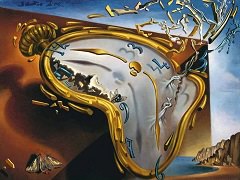Tuna Fishing, 1967 by Salvador Dali

Among the masterpieces Dali painted in his later period, Tuna Fishing occupies the most significant places. Dali was later quoted about this painting that he was trying to represent the notion of a finite rather than infinite universe, underscoring the idea "that all the cosmos and all the universe converge in one point, which, in the present case, is the Tuna Fishing. This accounts for the terrifying energy in this picture! Because all these fish, all those tuna, all the human beings in the act of killing them, personify the limited universe."
Dali spent two whole summers (1966 and 1967) to paint Tuna Fishing, a work full of dionysian figures. The picture was a kind of testament, the fruit of forty years of devoted searching for means of visual expression. In it, Dali combined all the styles he had worked in: Surrealism, "refined Pompierism", pointillism, action painting, tachism, geometrical abstraction, Pop art, and psychedelic art. The painting has proved as significant as his 1931 soft watch masterpieces The Persistence of Memory
The extraordinary photographic quality of Tuna Fishing is a tribute to Dali's skill, and also to his modernity in using a projector to place directly on to the canvas the images he wished to copy. The images themselves range from Hellenistic sculpture to the cinema. The slaughter of the fish is shown as a bloodbath which might equally well be a gladiatorial scene. The straining muscles and violent postures of the men are like figures on Sistine Chapel Ceiling by Michelangelo, heroically intense and glorying in the kill; by contrast, the authentic fishermen in the background are (literally) less colorful, going about their business with professional detachment.























